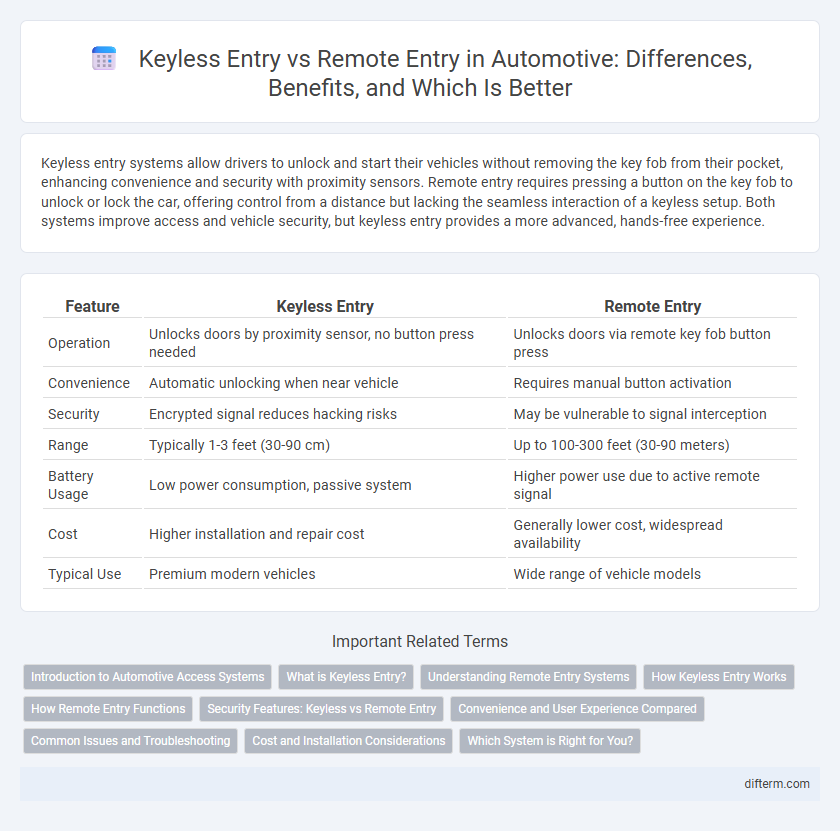Keyless entry systems allow drivers to unlock and start their vehicles without removing the key fob from their pocket, enhancing convenience and security with proximity sensors. Remote entry requires pressing a button on the key fob to unlock or lock the car, offering control from a distance but lacking the seamless interaction of a keyless setup. Both systems improve access and vehicle security, but keyless entry provides a more advanced, hands-free experience.
Table of Comparison
| Feature | Keyless Entry | Remote Entry |
|---|---|---|
| Operation | Unlocks doors by proximity sensor, no button press needed | Unlocks doors via remote key fob button press |
| Convenience | Automatic unlocking when near vehicle | Requires manual button activation |
| Security | Encrypted signal reduces hacking risks | May be vulnerable to signal interception |
| Range | Typically 1-3 feet (30-90 cm) | Up to 100-300 feet (30-90 meters) |
| Battery Usage | Low power consumption, passive system | Higher power use due to active remote signal |
| Cost | Higher installation and repair cost | Generally lower cost, widespread availability |
| Typical Use | Premium modern vehicles | Wide range of vehicle models |
Introduction to Automotive Access Systems
Keyless entry systems use proximity sensors to unlock car doors automatically when the key fob is nearby, enhancing convenience and security. Remote entry systems require pressing a button on a key fob to lock or unlock the vehicle from a distance, allowing control without physically approaching the car. Both technologies improve vehicle access but differ in user interaction and technological integration within modern automotive access systems.
What is Keyless Entry?
Keyless entry is an advanced automotive system that allows drivers to unlock and start their vehicle without using a traditional key, relying on electronic signals from a key fob or smart device. This technology enhances convenience and security by enabling passive entry and push-button ignition, reducing the risk of theft associated with physical keys. Keyless entry systems integrate with immobilizers and advanced encryption to prevent unauthorized access to the vehicle.
Understanding Remote Entry Systems
Remote entry systems use a wireless key fob to unlock and lock vehicle doors from a distance, improving convenience and security. These systems communicate via radio frequency signals that trigger door actuators, allowing for functions such as keyless locking, panic alarms, and trunk release. Understanding the range, battery life, and encryption protocols of remote entry systems is critical for optimizing vehicle access control and preventing unauthorized entry.
How Keyless Entry Works
Keyless entry systems use radio frequency identification (RFID) technology to communicate between the vehicle and a key fob, allowing doors to unlock automatically when the user is nearby. Sensors in the car detect the proximity of the key fob, enabling push-button start without physically inserting a key. This enhances convenience and security compared to traditional remote entry, which requires pressing a button on the key fob to unlock the doors remotely.
How Remote Entry Functions
Remote entry functions through a wireless transmitter that communicates with the vehicle's receiver, typically using radio frequency signals to lock or unlock doors from a distance. The key fob sends encrypted codes to the car's onboard computer system, ensuring secure access and minimizing unauthorized entry risk. This technology enhances convenience by allowing drivers to access their vehicle without physically inserting a key, unlike traditional keyless systems that may still require proximity or contact.
Security Features: Keyless vs Remote Entry
Keyless entry systems use encrypted signals and proximity sensors to allow secure access without physically pressing a button, reducing the risk of theft through signal interception. Remote entry relies on traditional RF signals that can be vulnerable to relay attacks, where thieves amplify the key fob signal to unlock the vehicle. Advanced keyless entry incorporates rolling code technology and motion detectors to enhance security against unauthorized access.
Convenience and User Experience Compared
Keyless entry systems enhance convenience by allowing drivers to unlock and start their vehicles without removing the key fob from their pocket, streamlining the user experience with seamless proximity detection. Remote entry requires pressing a button on the key fob to lock or unlock the doors, offering straightforward access but less fluid interaction compared to keyless setups. The continuous evolution of keyless technology emphasizes hands-free operations and integration with smartphone apps, elevating convenience and user satisfaction in modern automotive designs.
Common Issues and Troubleshooting
Keyless entry systems often face issues such as signal interference, battery failure, and sensor malfunctions, which can prevent the vehicle from unlocking or starting. Remote entry problems frequently involve faulty remotes, synchronization errors, or wiring issues that affect the transmitter's communication with the car. Troubleshooting typically includes replacing key fob batteries, reprogramming the system, or inspecting door lock actuators and wiring connections to restore proper functionality.
Cost and Installation Considerations
Keyless entry systems typically incur higher costs due to advanced technology and require professional installation to ensure proper integration with a vehicle's existing security features. Remote entry systems are generally more affordable and can often be installed as aftermarket additions with minimal technical expertise, reducing overall expenses. Cost-effective decisions depend on vehicle make, security preferences, and long-term convenience factors.
Which System is Right for You?
Keyless entry systems offer convenience by allowing drivers to unlock and start their vehicles without removing the key fob from their pocket, enhancing security with encrypted signals. Remote entry systems provide the ability to lock or unlock doors and sometimes control other features like trunk release from a distance, ideal for added flexibility. Choosing between keyless and remote entry depends on prioritizing seamless access and security versus extended control range and functionality.
keyless entry vs remote entry Infographic

 difterm.com
difterm.com